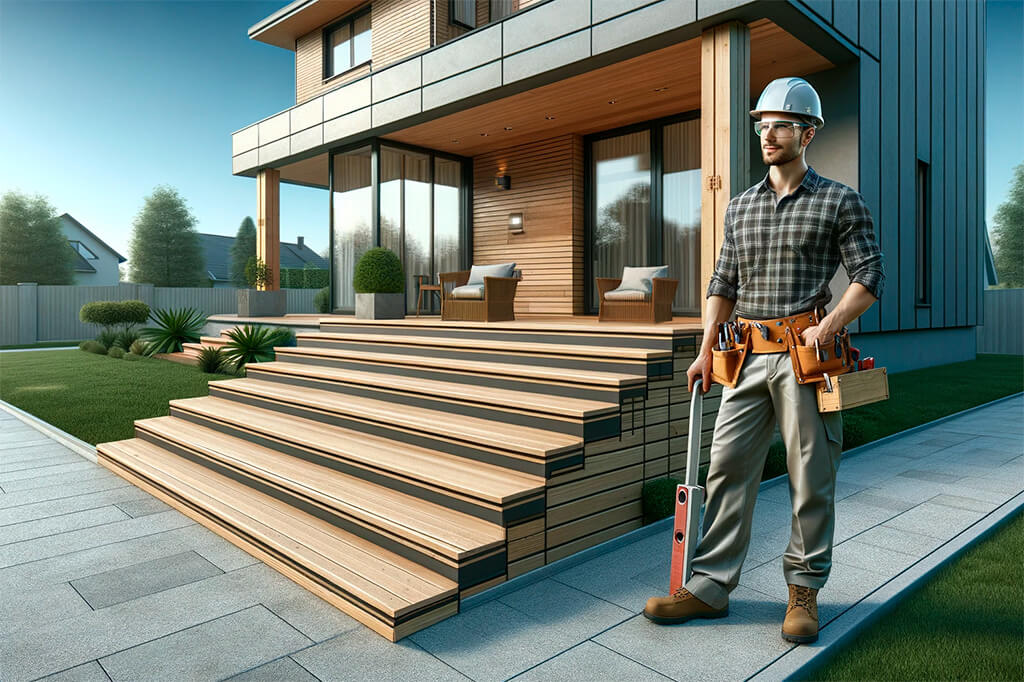Embarking on the journey of building your own outdoor wooden steps is not just about enhancing the functionality of your home, it’s about creating a welcoming entrance that speaks volumes about your craftsmanship and attention to detail. This skill is particularly valuable for home handymen and self-employed construction professionals, as it combines practical utility with an opportunity to showcase their expertise in a tangible, lasting way.

Understanding the Basics
Outdoor wooden steps are more than just a means to get from point A to point B. They are a crucial element in the overall aesthetic and safety of your home. The selection of materials here is paramount. You’ll want to opt for woods known for their longevity and resistance to the elements, such as pressure-treated lumber, cedar, or redwood. The right choice here is not just a matter of appearance, it’s a safeguard against future problems like rot, insect damage, and weather wear.
Planning and Design
Planning and designing your steps requires careful consideration and precision. Here’s how to approach it:
- Measure Your Space: Accurately measure the height and distance of the space where the steps will be built. This will dictate the number of steps needed. Remember, a comfortable step height is typically between 6 to 8 inches.
- Design for Your Space: The design of your steps should complement the architecture of your home and fit naturally into the landscape. Whether it’s a straightforward design or something more elaborate, ensure it serves both aesthetic and functional purposes.
- Consider Different Styles: The style of your steps should align with the look and feel of your property. For a rustic setting, chunky logs can create a charming, rugged look. In contrast, for more modern homes, sleek designs with clean lines can enhance the contemporary feel.

Materials and Tools Required
Gathering the right materials and tools is a critical step in this process. Here’s what you’ll need:
- Materials:
- Wood: Choose from pressure-treated lumber, cedar, or redwood based on durability and aesthetic preferences.
- Fasteners: Use galvanized or stainless steel nails and screws to withstand outdoor conditions.
- Stringers: These are the structural support of your steps, so accuracy in their selection and measurement is crucial.
- Tools:
- Saw: A circular saw or handsaw will be necessary for cutting the wood to size.
- Hammer or Nail Gun: Essential for fastening the steps together securely.
- Level: Ensures that each step is perfectly horizontal and stable.
- Measuring Tape: Precision is key in measuring, so always double-check your numbers.
Approach this project with a mindset focused on creating a durable, safe, and visually appealing entryway. With thoughtful planning and the right approach, your outdoor wooden steps can become a testament to your skill and an enhancement to your home’s charm.
Preparing the Site
When it comes to preparing the site for your outdoor wooden steps, think of yourself as an artist preparing a canvas. The success of your project hinges on how well this canvas is set up.
- Clearing the Area: Begin by removing any debris, rocks, or plant material. This step ensures a clean and obstruction-free workspace. It’s akin to setting a strong foundation for a house.
- Ensuring Level Ground: Use a level or transit to check the evenness of the site. An uneven base can lead to unstable steps, a problem that’s much easier to prevent now than to fix later.
- Laying the Foundation: In some cases, especially if the ground is soft, you might need to excavate a few inches and fill it with gravel for drainage and stability. Compact it thoroughly to provide a solid base for your steps.
- Outlining the Steps: Use stakes and string to mark the layout of the steps. This is your project blueprint, so precision is crucial. It’s not just about where the steps will lie, but also about ensuring they integrate seamlessly with your landscape.
Construction Process
Building outdoor wooden steps is a testament to one’s craftsmanship. It’s essential to approach this process methodically.
- Cutting the Wood: Accurate measurements are critical. Use a circular or miter saw for precise cuts. Pay special attention to the stringers – these are the framework of your steps and must be cut correctly for the entire structure to align properly.
- Assembly: Attach the stringers securely to your deck or landing. Then, methodically add the treads and risers, ensuring each is level and square. This step is where the visual aspect of your project begins to take shape.
- Securing the Structure: Opt for galvanized or stainless steel screws suitable for outdoor use. Each connection point should be robust and tight, ensuring the longevity and safety of your steps.

Finishing and Maintenance
The finishing and maintenance of your steps are what will preserve their function and appearance over time.
- Finishing Touches: Apply a high-quality sealer or stain to protect the wood from the elements. This not only prolongs the life of your steps but also enhances their appearance, adding to the overall aesthetic of your home.
- Regular Maintenance: Regularly inspect your steps for signs of wear, such as loose screws or rotting wood. Address these issues promptly to maintain the integrity of your steps.
- Keeping Them Clean: Regular cleaning is essential. Remove debris, snow, or standing water to prevent damage and ensure the steps remain safe to use.
This approach, focusing on meticulous preparation, careful construction, and ongoing maintenance, will result in a set of outdoor wooden steps that are not only a functional addition to your home but also a reflection of your dedication to quality and detail.
Troubleshooting Common Issues
In building outdoor wooden steps, encountering problems is part of the journey. The key is knowing how to effectively address these issues with tried-and-true solutions.
- Wobbly Steps: A common issue, often due to loose connections. Inspect the stringers and fastening points. Tightening bolts or adding reinforcement brackets often resolves this. Remember, stability is paramount.
- Wood Rot: This typically results from prolonged exposure to moisture. Regular inspection and maintenance, including resealing the wood, can prevent rot. In cases where rot has set in, replacing the affected parts is necessary to maintain the integrity of the steps.
- Uneven Treads: Uneven treads not only compromise the look of your steps but also pose a safety hazard. Use a level to check each tread. Minor adjustments can be made by sanding down high spots or shimming under low spots.
DIY Tips and Tricks
Over the years, I’ve gathered some practical tips that can simplify the process and enhance the safety and quality of your work.
- Use Templates: Creating a template for stringers can ensure uniformity and save time. A cardboard or plywood template is a practical tool for this.
- Pre-Drill Holes: To prevent wood splitting, especially at the ends, pre-drilling holes is a wise practice. It’s a simple step that can significantly improve the longevity and appearance of your steps.
- Custom Touches: Personalizing your steps can transform them from mere functional structures to distinctive elements of your home. Consider unique railings or artistic carvings to add a personal touch.
FAQ Section
Choosing the right wood is crucial. Pressure-treated lumber is cost-effective and durable, while cedar and redwood offer natural resistance to rot and pests, along with aesthetic appeal.
Safety and stability hinge on correct design and construction. Ensure adequate spacing of stringers, use robust fasteners, and regularly inspect for any wear or damage.
Avoid using non-resistant materials in outdoor settings, inaccurate measurements leading to uneven steps, and insufficient structural support. Accurate planning and careful execution are key.
Measure the total rise and run of the space. Divide these to find the number of steps needed, adjusting the dimensions slightly for a perfect fit. Always prioritize safety and comfort in your calculations.
